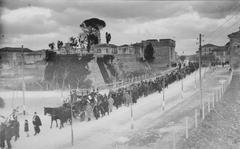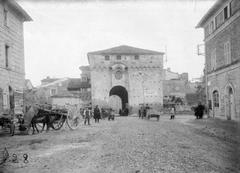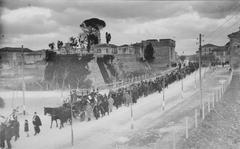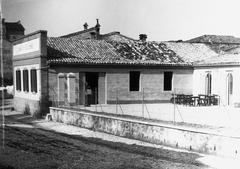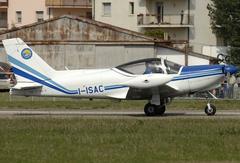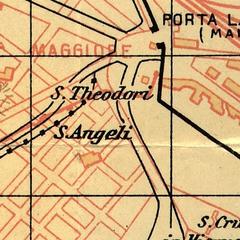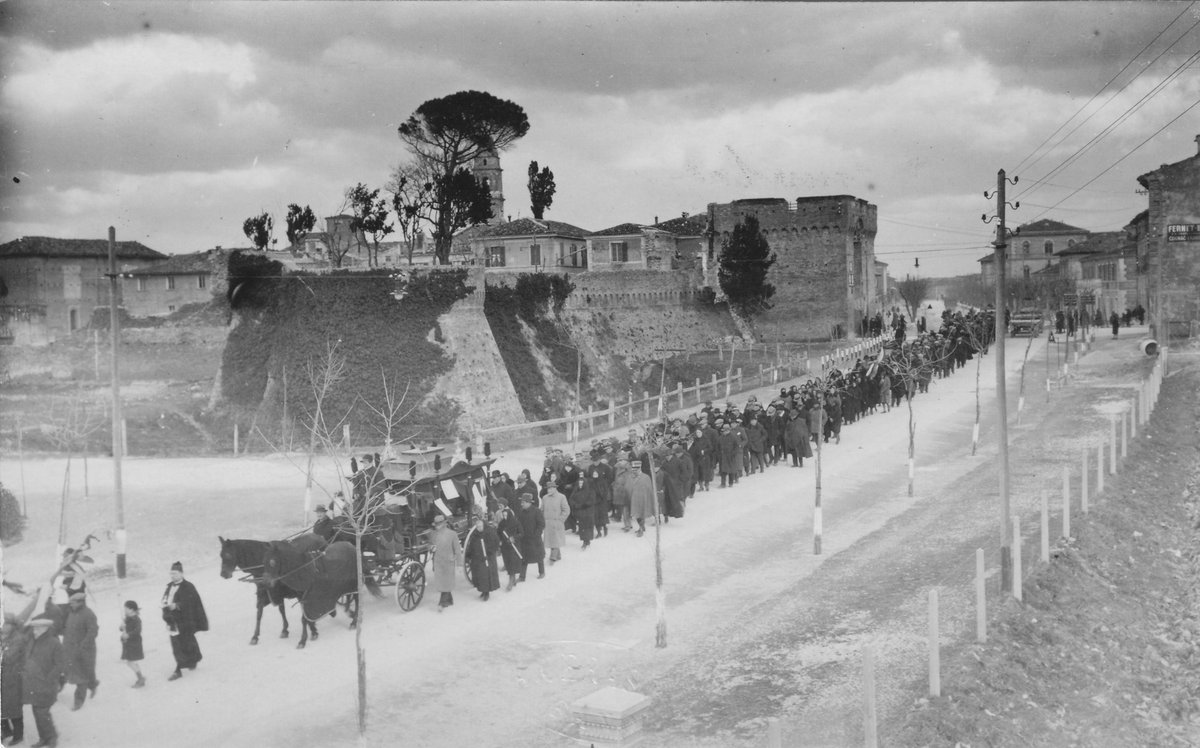
Porta Maggiore Fano: Visiting Hours, Tickets & Historical Sites Guide
Date: 14/06/2025
Introduction
Porta Maggiore in Fano, Italy, is a remarkable monument that embodies the city’s rich historical and architectural legacy. Originally constructed in 1227 during a period of urban expansion, this iconic city gate bridges Fano’s Roman origins with its medieval and Renaissance transformations. Strategically positioned opposite the celebrated Roman Arch of Augustus, Porta Maggiore is both a physical threshold and a symbol of Fano’s enduring civic, cultural, and defensive identity. Today, the site is an open-air monument, freely accessible and integrated into Fano’s public parklands, making it a must-see destination for history enthusiasts and curious travelers alike (visitfano.info; lavalledelmetauro.it).
Table of Contents
- Historical Overview
- Architectural Features
- Visiting Porta Maggiore
- Cultural Significance
- Frequently Asked Questions (FAQ)
- Practical Visitor Summary
- Sources and Further Reading
Historical Overview
Roman Origins and Medieval Development
Fano, once known as “Fanum Fortunae,” was a Roman colony strategically positioned along the Via Flaminia. The original city gate, constructed under Emperor Augustus in 9 AD, marked the beginning of the decumanus maximus and was part of a broader program of urban development that included the Augustus Arch and defensive city walls (visitfano.info). Throughout late antiquity and the Middle Ages, these fortifications were modified to address evolving military and civic needs.
By 1227, as Fano expanded beyond its Roman boundaries, Porta Maggiore was built as the new principal entrance. This gate reflected both the increased flow of people and goods and the city’s need for improved defenses (visitfano.info; guideturisticheurbino.it).
The Malatesta Era and Renaissance Reconstruction
Between 1339 and 1463, the Malatesta family ruled Fano, further reinforcing the city’s walls and fortifications. Porta Maggiore was severely damaged in 1463 during the siege by Federico da Montefeltro. Architect Matteo Nuti later led a comprehensive reconstruction, incorporating Renaissance defensive innovations such as the Bastione del Nuti, gun embrasures, and a more robust, lower profile suited to withstand artillery attacks (lavalledelmetauro.it; lavalledelmetauro.it).
Architectural Features
Gate Structure and Materials
Porta Maggiore features two main entrances—a larger arch for vehicles and a smaller one for pedestrians. The gate was constructed using stone from Monte Nerone, providing a distinctive look compared to the city’s interior sandstone buildings. The robust, parallelepiped-shaped blocks were laid with continuous horizontal joints and staggered seams for maximum defensive strength (lavalledelmetauro.it).
Defensive Innovations
Matteo Nuti’s Renaissance reconstruction introduced several defensive features:
- Bastione del Nuti: A squat, thick-walled bastion with sloped walls, designed to support artillery and provide flanking fire along the city walls.
- Cannon Embrasures (Cannoniere): Openings on either side of the gate allowed defenders to target attackers approaching the entrance.
- Towers: Originally, two flanking towers provided additional defense, with limited access and narrow slits for observation.
- Dual Passageways: Separate arches for foot traffic and carts ensured efficient control over movement and security.
Symbolism and Ornamentation
Beyond its military function, Porta Maggiore was a monumental city entrance symbolizing Fano’s civic pride. Classical elements such as arches, pilasters, and sculptural keystones echoed the city’s Roman heritage. Incised crosses and other subtle details inside the arches reflect layers of religious and ceremonial significance (lavalledelmetauro.it).
Visiting Porta Maggiore
Opening Hours & Ticket Information
- Access: Porta Maggiore is an open-air monument accessible at all hours; no ticket is required.
- Guided Tours: Local operators and the Fano tourist office provide guided walking tours that include Porta Maggiore and other historical sites. Advance booking is recommended, especially during peak seasons (WildTrips; ILiveItaly).
Accessibility & Getting There
- Location: The gate is situated on Via Flaminia, facing the Arch of Augustus, and is within walking distance of Fano’s city center.
- Parking: Public parking is available nearby, though spaces may be limited during busy periods.
- Mobility: The surrounding area is paved and generally suitable for visitors with mobility challenges, though some nearby streets are cobbled.
Travel Tips
- Best Times: Early morning or late afternoon offer the best lighting for photography and a quieter atmosphere.
- Seasonal Advice: Peak season (June–August) brings crowds and higher prices; shoulder seasons (April–May, September–October) are more relaxed.
Amenities and Nearby Attractions
- Food & Refreshments: Numerous cafes and restaurants are located within a short walk, featuring local Marche cuisine (ILiveItaly).
- Restrooms: Public restrooms are available near major squares and the tourist office.
- Other Sites: The Arch of Augustus, Pincio gardens, Malatesta Fortress, and various museums are all easily accessible on foot.
Cultural Significance
Porta Maggiore is not only a historical relic but also an active part of Fano’s cultural landscape. The gate serves as a dramatic backdrop for events such as the annual “Fano dei Cesari” festival, which includes historical reenactments and processions (visitfano.info). Its integration into daily city life, local events, and festivals makes it a living monument, fostering a connection between past and present.
Frequently Asked Questions (FAQ)
Q: Are there tickets required to visit Porta Maggiore?
A: No, access is free and open at all times.
Q: What are the best visiting hours?
A: The site is accessible 24/7, but early morning or late afternoon are ideal for photography and fewer crowds.
Q: Are guided tours available?
A: Yes, through the Fano tourist office and local operators.
Q: Is Porta Maggiore accessible for visitors with mobility challenges?
A: The area is generally accessible, though some nearby streets may be uneven.
Q: What other historical attractions are nearby?
A: The Arch of Augustus, Pincio gardens, Malatesta Fortress, and city museums are all within walking distance.
Practical Visitor Summary
- Original construction: 1227; major Renaissance reconstruction post-1463 by Matteo Nuti.
- Location: Via Flaminia, facing the Arch of Augustus, Fano.
- Structure: Two main arches (vehicle and pedestrian), robust stonework, defensive bastion and cannoniere.
- Access: Open 24/7, free entry.
- Facilities: Nearby cafes, restrooms, tourist office, accessible paths.
- Tours: Recommended for historical context; advance booking advised during high season.
- Cultural Events: Hosts events and festivals, especially in summer.
Sources and Further Reading
- Porta Maggiore Fano: Visiting Hours, Tickets, History & Travel Guide, VisitFano.info
- Visiting Porta Maggiore in Fano: Hours, Tickets, and Historical Insights, LaValleDelMetauro.it
- Porta Maggiore Fano: Visiting Hours, Tickets & Historical Insights, VisitFano.info
- Porta Maggiore Fano: Visiting Hours, Tickets & Guide to Fano Historical Sites, WildTrips
- Porta Maggiore Fano: Visiting Hours, Tickets & Guide to Fano Historical Sites, ILiveItaly
Enjoyed this guide? Download the Audiala app for interactive maps, personalized travel tips, and up-to-date event information. Share your Porta Maggiore experience with #VisitFano and stay connected for more travel inspiration!
